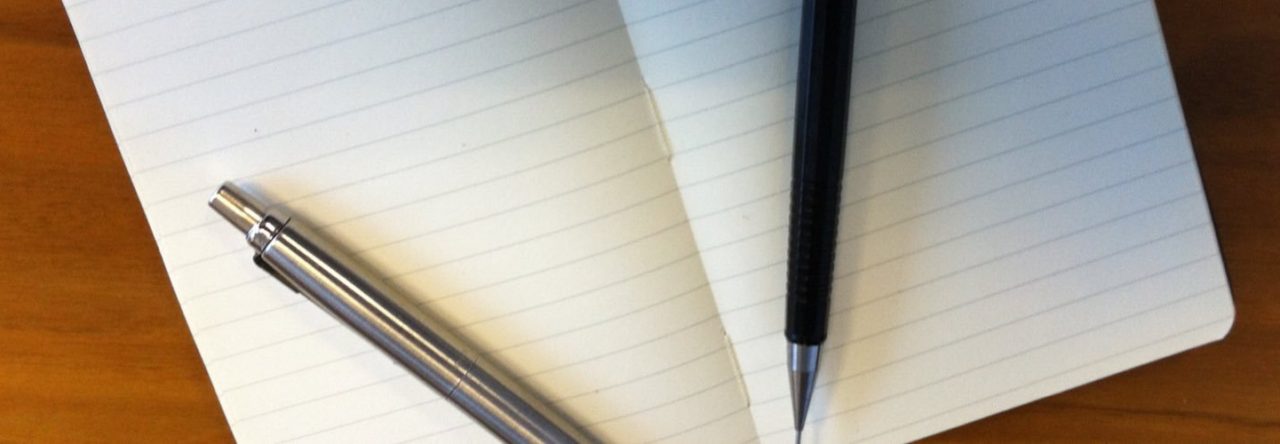Category: Link Page 1 of 54

Hello, you all right? I hope so. And if you’re not, then I’m flattered or appalled that you’re here, though in all honesty you might be better off dealing with whatever it is that’s making you not all right than reading my nonsense…
But to business: for a variety of reasons which are so well publicised that I don’t need to list them here (and history will list them as well), 2020 has been a year when many of us have been unable to travel – and in fact, most people have been constrained to moving within a very small radius centring on their home.
So, for people (myself included) who like travel, and mountain vistas, I thought you might enjoy the facility offered at this link – National Geographic are hosting a virtual re-creation of the view from near to the top of Mount Everest (aka Sagarmatha, aka Chomolungma, aka the highest mountain on the planet), and you can interact with it, rotate and zoom and so on. All without the usual dangers of being at high altitude (don’t want to sound bleak, but there’s a reason why the upper areas of Everest are called the Death Zone).
Notwithstanding that the land on one side of the mountain seems to be labelled China when it really ought to say Tibet (sigh, cue eyeroll) I think it’s a pretty glorious image, and is one of those things that – like looking out to sea, or at a sky painted with stars on a cloudless night – reminds one of the vastness of existence, and the gosh-darned amazingness of this world we live in.
This year, I’m making a concerted effort to read more books by women, and so recently I decided to read some Jane Austen. I read Emma years ago at school, but that was a different kind of reading (and I guess that with it being decades ago, you could say that I was a different kind of reader). Austen’s often cited as a great writer, and arguably her most famous work is Pride and Prejudice, so that was the one I picked.
My emotions, once I’d finished it, were kind of mixed – to follow Austen’s approach to titling, I’d sum them up as being Amusement and Anger.
Let me explain…
The opening line of P&P (as the groovy cats all call it, so I’ll call it from here on) is famous, and oft-quoted – so much so that I commented on this in a tweet from 2015:
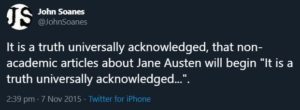
That’s right, I’m quoting myself to back up my point. Bold, I know.
But… well, okay, let’s just quote the line for those of you who may not be familiar with it:
“It is a truth universally acknowledged, that a single man in possession of a good fortune must be in want of a wife.”
Pretty bold assertion, really, presented as something which is both true and held to be true (reminds me of that bit in the US Declaration of Independence, “We hold these truths to be self-evident…”), and I’ll be honest with you, it’s never really rang true for me – I understand that Austen’s setting out her whole premise for the book, really, but when ever I’ve seen this line quoted it seems to be saying ‘this is the basis of the story, and everything spins from here, so accept it as true’, and that’s never really sat well with me – not just because the social aspect lurking in it is very old-fashioned to modern eyes, but also because there must have been people even in Austen’s days who didn’t feel that way (must have been some men with a fortune who didn’t want a wife, for whatever reason, surely?).
As I say, I’ve only ever seen this line quoted with no knowing wink or suggestion that it’s a joke, and … well, to my mind, it is a joke (or at least the setup of one), because the next line totally undermines it – here it is:
“However little known the feelings or views of such a man may be on his first entering a neighbourhood, this truth is so well fixed in the minds of the surrounding families, that he is considered the rightful property of some one or other of their daughters”
… so Austen says that ‘everyone knows that a single man with money wants a wife’ and then follows up by saying ‘I mean, if one moves into your town, unmarried daughters basically think he’s their property’. Feels like a joke to me, and – olde worlde language and ideas aside – not a bad one (probably not least because I’d always seen the first line presented as a self-contained statement of fact, not the feed line of a sarcastic joke).
So, that was page one, and I started to wonder if the people who’ve adapted Austen’s books over the years, and who talk about her work, seem to be misrepresenting; the seeds of my amusement and anger, before I was even a page into the book. Hmm.
Because as I read on, amusement was a consistent feature of my experience of P&P, as it is genuinely funny (though as I mentioned above, some of the jokes are kind of buried in the formal language, or poking fun at social conventions which are now very outdated, though in its way that shows how progressive Austen’s thinking was), with the dialogue in particular containing a lot of sharp retorts and … well, the ancestors of the sort of snappy patter that so many onscreen will-they-won’t-they couples have traded ever since.
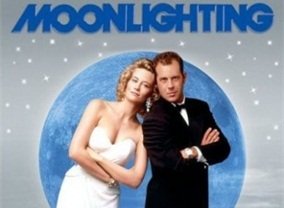
This TV show lived – and died – by that dynamic
As I say, quite a bit of the humour has a sarcastic edge to it – for instance, there’s a sequence (I read the feedbooks ePub version – this was p54 if you want to read along) where Miss Bingley tries to flirt with Darcy (don’t forget it’s universally acknowledged that he has money and a pulse and therefore is up for grabs) by sitting next to him while he reads, and pretending to read the book that follows from the one he’s reading – though of course she has no idea of what it’s about, not having read the first one, and then she says “There is no enjoyment like reading! How much sooner one tires of anything than of a book!”
Oddly enough, I often see this quote on tote bags and the like, attributing it to Austen herself, which feels a bit off as the character who says it hasn’t even been reading properly, and the line’s designed to show she’s insincere – odd that it’s often quoted straight when it seems to be sarcastic in intent.
One thing which I really enjoyed was that Austen seems to be very aware that people kind of ‘enjoy their emotions’ – I don’t just mean the tendency which a lot of people show nowadays to be ready to be offended (often on other people’s behalf, which feels a bit hmm), but Austen’s very astute about the fact that people get a bit of a thrill about holding strong opinions on things – obviously there are people on TV and in the newspapers who’ve made a career out of being professionally controversial (my thoughts on that career path, in summary: I question their sincerity), but I’m also reminded of a lot of people online who seem to enjoy being firm about their opinions, at being appalled or impressed by something, and jumping quickly into whichever team that makes them part of, all of which may not leave much room for nuance or uncertainty, which is often much-needed.
Austen seems to have a terrific handle on this, both the phenomenon and the delight people take in being part of it, as she wrote that Elizabeth Bennet wallows in her feelings by taking “a solitary walk, in which she might indulge in all the delight of unpleasant recollections” (ch 14) and later that she “meant to be so uncommonly clever in taking so decided a dislike to him, without any reason” (p215) – that latter remark feels very much like today’s online snarking and trolling, to my mind.

Colin, the energy vampire from What We Do In The Shadows wants to tell you why you know nothing
I mentioned a couple of lines ago about people enjoying being on a team where they’re all holding one opinion, and Austen seems aware of how team spirit can turn into mob mentality, noting that a group of people “indulged their mirth for some time at the expense of their dear friend’s vulgar relations” (ch 8) and that other people could be swayed by this pack mentality when it comes to holding opinions as “their indifference… restored Elizabeth to the enjoyment of all her former dislike” (same chapter). I think Austen’s on to something quite important here – not only the way people behave, and the opinions they hold, but the way it makes them feel when they do so; delighted to have someone to look down on, or just pleased to be able to hold a strong opinion.
Of course, the problem with aligning yourself to a position this way is that if you turn out to be basing it on an incomplete picture, or there’s some dramatic change of events, you need to change your position, but without in any way looking like your judgment might be as flawed as it actually is, and Austen nails this fickleness of opinion, and our ability to rewrite it on p275 when it turns out that one character was a bad ‘un, and we’re told that “Everybody decided that he was the wickedest young man in the world; and everybody began to find that they had always distrusted the appearance of his goodness”. I’m sure we can all think of a number of instances where people have suddenly claimed never to have liked someone or something because there’s new evidence against, even if they seemed a fan previously…

Generic image: impose your own idea of someone whose work you liked but who put you in an awkward position psychologically by turning out to be profoundly unpleasant
The social stuff underlying much of the story looks pretty old-fashioned now, and the plot arc seems to tend inescapably towards characters getting married, but that doesn’t necessarily mean that the men are all moustache-twirling predators (though some are close – I’ll get to that in a few lines’ time) and the women utterly subservient and happy to marry someone as long as he’s got a good fortune and a backbone.
The main character, Elizabeth Bennet, is solidly defined, with her own opinions, though this does bring her into conflict with some, as (in ch18) Mr Collins cheerfully says “… I consider myself more fitted by education and habitual study to decide on what is right than a young lady like yourself.”
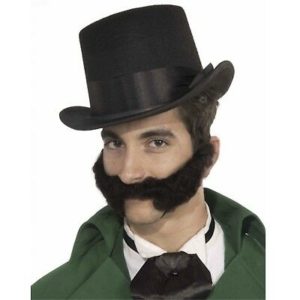
This would be his Twitter avatar
Whoa. I mean, he’s modern in that he comes over like a man replying to a woman online – and actually, in the story, he proposes marriage to her the next morning, so in a way he’s like some kind of proto-Pick Up Artist, ‘negging’ Elizabeth in the hopes that that her self-esteem will take such a bash she’ll do anything to get him to like her (spoiler: it doesn’t work, she marries Darcy).
Speaking of Darcy, the romance element of the book was almost surprising to me, as I’d been under the impression that the whole thing was like Much Ado About Nothing or When Harry Met Sally or the like, in that I expected Elizabeth Bennet and Fitzwilliam Darcy to say they didn’t like each other until the final chapter or so, when misunderstanding would be untangled, and they’d declare their love for each other at an annual ball or something like that.
But Austen uses the narrative trick of a generally quite all-knowing narrator, and so we get insights into the characters which kind of short-cut that sort of thing, as in ch10 when she states matter-of-factly “Darcy had never been so bewitched by any woman as he was by [Elizabeth]”. According to my e-version of the book, this is about 13% of the way in, and when it comes to Elizabeth actually being made aware of this, even that isn’t at the end – what would probably be expected to be the big reveal at the end comes about midway through it… reminding me of the terrific revelation in Gone Girl (both the book and the film).
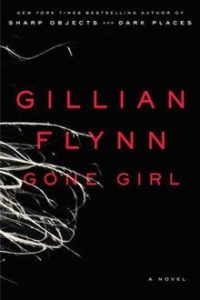
Spoiler: the girl is gone
As an aside, I found it interesting how little of the time Darcy’s actually present on the page – he’s like Holmes in The Hound of The Baskervilles or a plot catalyst like the imprisoned Hannibal Lecter, with other characters reacting to him and speculating about him. Perhaps this is a version of the ‘blank page’ thing, where the other characters and the readers alike, in the absence of concrete details, project their own ideas and expectations onto him?
On a related note to the above, one thing which stood out to me was a general absence of physical details or descriptions of the characters, though Austen often them as being handsome or agreeable-looking without being specific; in a way, this makes their appearances almost future-proof as if she knew that what was attractive in 1813 when P&P was published might well change; a healthy tan from the sun isn’t likely to have been an expected feature at that time, I’d imagine, but now that might be cited as appealing. Similarly, Austen sometimes cites character traits without actually showing them in action, which feels like a classic case of telling, not showing, but generally it works.
Just to break up the format a bit here (and mindful of the long sentences I appear to be unable to avoid using), some bullet-points with stray thoughts about the book:
-
There’s a character called Jane, who we’re frequently told is attractive, and this made me laugh – yes, I know she wasn’t named on the cover of the book at the time of publication, but this is kind of funny and would probably be rare now… though when I think about it, Clive Cussler put himself into loads of his Dirk Pitt novels, and it seems pretty obvious that James Bond was living a life Ian Fleming seemed to want. So perhaps Austen was one of the first women to do this kind of self-fictionalisation?
-
Quite often, I lost the thread of who was being talked about – there are four ‘Miss Bennets’ in the book, and it’s not always clear who’d being discussed, and sometimes pronouns like ‘she’ are used in sections with multiple female characters, so you can end up having to re-read bits to make sure of your understanding. The sort of thing that might be caught by a line edit nowadays, I guess.
-
There’s a very Wildean epigram (pre-dating Wilde’s birth by four decades, so I’m not suggesting plagiarism) on p319: “We all love to instruct, though we can teach only what is not worth knowing”
-
There’s a key turn of events just after midway in the story when Darcy writes Elizabeth Bennet a letter, revealing to her (and the reader) a whole load of stuff which has happened off-page, but which Elizabeth has reached inaccurate conclusions about. In terms of sheer text on the page, the long letter from Darcy is a huge infodump, but then again it’s realistic for a means of communication at the time … there’s a follow-on sequence of Elizabeth working through her emotions and thoughts as a result of the fuller picture she now holds, which in all honesty I found kind of dense and often tangled, and I was wishing by the end of it that this section had been woven in to the narrative of Darcy’s letter (alternating his comments and her reactions), though then again it did shine a light on what we’d now probably now call ‘cognitive dissonance’ on her part (that is, she thought Darcy was more mean-spirited than he actually was).
-
I alluded to the omniscient narrator approach above, and there’s a slightly odd case of this when the reader only sees how ‘vulgar’ Elizabeth’s sisters are in their demeanour after Darcy’s letter comments on this, and Elizabeth re-views events through that lens now (esp in Pt2, Ch16), but this feels like a bit of a need for the reader to also go back and re-frame their perception of those events, as we haven’t actually had this depicted as sharply in the narrative before. I guess it’s not exactly an unreliable narrator here (I refer you to Gone Girl, cited earlier), but we could charitably refer to this as withholding, or what m’colleague has referred to before as a ‘veiled plot’, but then again one might argue it makes it necessary for the reader to the kind of re-writing of ill-informed conclusions that the characters in the books have to do on a number of occasions.
So, the above is (whether it’s clear or not) derived from my Amusement… what of the Anger I referred to? Well (takes breath)…
I’m angry and annoyed because I feel I would have read Austen for fun much earlier in my life if it had been pushed as being funny – because it is funny; it’s got snappy lines and comedic setups and misunderstandings and cutting putdowns and the like, and lurking under it is a very astute angle on the social expectations of the time (in, to be fair, a very limited section of society). But aside from people occasionally talking about Austen as a social commentator or satirist, I’ve never come across any promotional material for an adaptation of Austen which made this the principal selling point.
Instead, the film and TV adaptations are all lavish, with expensive sets and accurate costumes, but nowhere do they seem to play up the comedy angle. It feels like convincing me to see Bridesmaids because they’ve got a beautifully-recreated set of a wedding shop, and forgetting to mention the funny. I used to say (and I’d be surprised if I was the first to do so) that costume dramas on TV were all costume, no drama, and it feels like the sheer comedy of Pride and Prejudice has been lost as people get distracted by the bonnets, balls, carriages and so on.
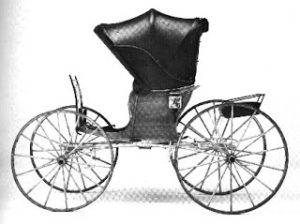
Take out the gags, show this pulling up outside a Manor House, it’s what Jane would have wanted
As I was reading the book, I was reminded of how Steven Moffatt and Mark Gatiss had said that the reason Sherlock Holmes was update-able material was because at its core, it’s not about gaslit streets and visiting cards on silver platters and all that Victoriana, it’s about the mystery, and the characters, and so on. And just as the film Clueless took Austen’s Emma and updated it and made it clearly a romantic comedy, I can’t help but think that the fact that P&P is a comedy at heart (and it has heart, yes, it’s a romantic comedy) means it should be eminently possible to adapt it for the screen without getting fixated on the production design. Pride in the big budget adaptations, it seems, led me to develop a Prejudice against the source material.
Because if you can do that, I suspect you might find there are people who would be pleasantly surprised to realise it’s actually a comedy. Because – if I haven’t made it clear from the thousands of words I’ve expended right here in this blogpost – I’m one of those people, and I’m sure I’m not the only one who can get over being Annoyed (at having felt at arm’s length due to mis-selling of the material) if you can make me sufficiently Amused once you draw me in.
(Or ‘The Jacob Marley of posts – by which I mean it’s heavy-laden with links’)
As noted in yesterday’s post, this is a predominantly indoorsy time, so I thought I’d share some stuff that might be of interest – I am, as I hope is clear, in no way saying “you must do this” about any of the following (especially the physical activities suggested), it’s really just a list of things that I’ve enjoyed, and you might too. So with that (hopefully kind of unnecessary) caveat out of the way, on to the list, with its arbitrary categories:
Physical activities
Being indoors all the time is hardly conducive to a lot of exercise – unless you’ve got loads of weights or one of those Peleton things – so it’s probably useful that in the UK one of the accepted reasons to go outside is once a day for exercise. But for people who can’t do that – no open spaces nearby, for example – a lot of folks in the health and fitness business have made their stuff accessible online; you’ve probably seen that Joe Wicks is doing daily workouts every morning, but I thought I’d share a few others. Key thing, I feel, is to find what works for you – they often say that mental and physical health are linked, so keeping the blood flowing is likely to help you stay chipper at this odd time.
I’ve embraced yoga in the last few years and found it’s very much for me, and luckily a couple of my teachers have gone online recently:
Meg of Real Life Yoga is one of the funniest teachers I’ve ever had, as you can probably tell by the video she’s posted of a yoga sequence to do if you’ve got a hangover; but she’s also posted some short, non-morning-after videos aimed at people who are working from home, which are worth a look.
Charlie is a very friendly and supportive teacher and I’ve attended his lessons several times, including a beautiful session in a candlelit church; he’s posted some instructional videos online especially for this time. They’re free to view, but if you can make a contribution that’d be lovely.
I’m currently six weeks into the at-home programme of Broga,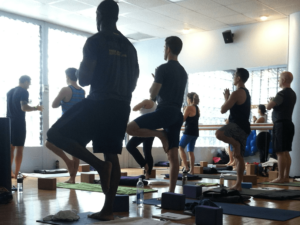 which is (as the name suggests) a version of yoga originally aimed at men (or at least, aimed at getting past male preconceptions about whether yoga is for them). It’s hard work, and more actively so than most yoga I’ve experienced, but it’s one of those workouts where you really feel the endorphins and the sense of achievement when you’re done. I’m using the DVD, but they’re very kindly hosting live classes online; as I understand it, you go to their Instagram page and press the Live button, and you should be good to go (I can’t be sure – I’m not on IG myself). Good news here is that not only are many of their instructors donating their fee to charity for doing these classes, but they’re also running additional classes, including ones for families, so definitely worth a look.
which is (as the name suggests) a version of yoga originally aimed at men (or at least, aimed at getting past male preconceptions about whether yoga is for them). It’s hard work, and more actively so than most yoga I’ve experienced, but it’s one of those workouts where you really feel the endorphins and the sense of achievement when you’re done. I’m using the DVD, but they’re very kindly hosting live classes online; as I understand it, you go to their Instagram page and press the Live button, and you should be good to go (I can’t be sure – I’m not on IG myself). Good news here is that not only are many of their instructors donating their fee to charity for doing these classes, but they’re also running additional classes, including ones for families, so definitely worth a look.
And in the world of yoga, one of the most well-known online instructors is, of course, Adriene – millions of subscribers and dozens of videos, suitable for beginners and expert alike, with a whole variety of durations; basically something for everyone, and a great place to start (the only reason I mention her further down the list here is because I wanted to start off with teachers and styles I have personal experience of).
Of course, yoga isn’t the only kind of exercise you can do indoors, and for many other ideas I heartily recommend Nerd Fitness – a site that doesn’t take itself seriously, but does take exercise seriously, and has a slew of great resources and exercise plans: for obvious geek reasons, I like their Batman Bodyweight Workout, but there are loads of other at-home workout routines. Definitely deserves a look, not least for the great Lego setups that illustrate so many of their articles.
Lastly on the physical exertion topic, I like to run – granted, it’s not for everyone (and not everyone is allowed out at the moment), but if you’re thinking this might be the time to try it out, then a lot of people I know (including m’colleague) have had a lot of success with Couch to 5K, often surprising themselves with just how much progress can be made in a pretty short period of time.
Meditation
Mens Sana in Corpore Sano, as the Romans had it (apologies for that Juvenal joke), and it’s probably fair to say that in the last few years topics of mental health and well-being have been much more openly discussed, with mindfulness and meditation being … well, I’d like to say ‘increasingly popular’, but I have no evidence of that to hand. But I’ve certainly seen a lot more articles on those topics in the papers and magazines, and they seem to get a lot of mentions in podcasts and the like, so I’ll assume this is in some way reflected in reality.
I’ve been a fan of meditation since my teens, and whilst I wish I could pretend that means I’m an expert at it, it still feels like something that I can still learn a lot about – that said, I’ve found it a great way of just getting centred and feeling a bit more in control of one’s thoughts and actions, particularly during turbulent times, so I’d recommend it – here are a couple of apps you can get for smartphones:
Insight Timer – my app of choice, it’s free and you can create your own sessions (selecting duration and background sounds), or listen to the guided meditations or talks by noted experts like Tara Brach.
Headspace – probably better known than Insight Timer, and a lot of people swear by it. It didn’t quite do it for me, but that’s probably just me trying to pretend I’m some kind of maverick, swimming against the tide and not liking the same stuff as everyone else. Yeah, lookit me, I’m a rebel. Ahem.
Calm – again, a very popular app, this one has a particularly elegant style (just click on Get Started and enjoy the interface), and even has bedtime stories read by people like Stephen Fry.
As ever, there are a wealth of resources online for this kind of thing, and since meditation essentially boils down to sitting comfortably, closing the eyes and focusing on the breath (as a starter; that’s not the entirety of it, obviously), you should be able to get started for pretty much the sum of zero pence. The best things in life can, after all, be free.
Right, so that’s enough of you looking after yourself, let’s move on to entertainment…
Streaming TV and Films and stuff
I’m not even going to try to list everything that’s available (I know that, for example, the BBC have put loads of box sets of TV series onto iPlayer, and I’m sure you know what kind of thing you’re into), but here are a couple of things I have found and enjoyed…
Netflix – As well as six seasons of Brooklyn Nine-Nine, a delightfully warm-hearted and upbeat comedy, I recently found and thoroughly enjoyed the film Extra Ordinary; 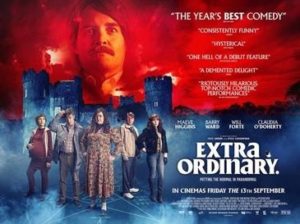 put me in mind of a cross between Derry Girls and Ghostbusters, and is a lot of fun. I wasn’t familiar with the cast or creatives involved (apart from Will Forte, who seems to be having a lot of fun), but they’ve all done a terrific job. Really worth your time.
put me in mind of a cross between Derry Girls and Ghostbusters, and is a lot of fun. I wasn’t familiar with the cast or creatives involved (apart from Will Forte, who seems to be having a lot of fun), but they’ve all done a terrific job. Really worth your time.
iPlayer – As mentioned above, they’ve put a whole load of shows up to help the nation stay entertained while we’re all indoors, and whilst the list could go on for ages, I’d particularly highlight the fact that every episode of Inside No.9 is there to be watched; they’ve just finished their fifth series, and it’s maintained a consistently high standard, to the extent that I wonder if I, as a viewer might be in danger of taking for granted just how ruddy good it is. If you’ve not seen it yet, this is a great chance to catch up.
And possibly hidden in the films section on iPlayer is the frankly bonkers film Mindhorn , which is funny, clever, and only about 85 mins, so it doesn’t have time to drag. That’s how to do it.
, which is funny, clever, and only about 85 mins, so it doesn’t have time to drag. That’s how to do it.
All4 – I mentioned above that some programmes are so good that it’s easy to almost overlook that consistent quality – and Friday Night Dinner is one of them. The sixth season is currently showing on Channel 4, and there’s no drop in story quality whatsoever, and the performances are just as solid… by which I mean solidly ridiculous, most of the time. All the episodes are currently available to view on All4.
Oh, and I mentioned Derry Girls earlier, which is also on the All4 site, and which is terrific.
Aside from the above (and other streaming services which I don’t have and so haven’t mentioned), there are some interesting cultural whatnots worth checking out:
National Theatre Live – in the last couple of years, the National Theatre have taken to screening filmed versions of some of their plays (and transmitting them to cinemas around the country, which strikes me as a clever way of getting stuff seen by people who (a) don’t live nearby or (b) don’t know if they want to spend forty quid or more on a production they may not like that much).
As theatres are closed right now, the NT has started screening a play every Thursday on their YouTube channel, and it remains there for a week, so don’t feel you have to watch it in real time. As I type this, Jane Eyre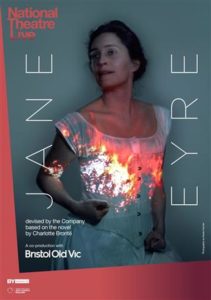 is the current play, and I believe that one of the future presentations will be the production of Twelfth Night from a couple of years ago, starring Tamsin Greig, which I thought looked interesting, but never got to see, so I’ll be looking out for that.
is the current play, and I believe that one of the future presentations will be the production of Twelfth Night from a couple of years ago, starring Tamsin Greig, which I thought looked interesting, but never got to see, so I’ll be looking out for that.
Royal Opera House – In a similar vein, the ROH are screening a selection of performances of opera and ballet on their YouTube channel. I’ll cheerfully admit that whilst I like me a bit of opera, ballet’s a bit of a blind spot to me, but maybe this is the perfect time for me to try some, with time and money less at risk if I do so? Worth a look.
Podcasts – are like the radio shows you can pause and rewind, and so are a great way to hear other people’s voices, and opinions, and learn stuff and laugh (or all of those things). Plus you can get on with stuff like washing and tidying while they keep you company. I’m sure you can find a ‘cast (that’s what the cool kids call them, don’t let anyone tell you otherwise) on a subject of interest to you, but the following are ones which I always enjoy:
How to Fail – Elizabeth Day talks to successful people, about how they’ve been shaped by their failures… that’s a really dry summary of a really interesting show.
Scriptnotes – John August and Craig Mazin’s long-running ‘cast about writing. Mainly for the screen, but loads of lessons about creativity and the like anyway (this week’s episode has Ryan Reynolds and Phoebe Waller-Bridge as guests! How cool is that? Well, actually I don’t know how cool, as I haven’t listened to it yet. But I’ve listened to the previous 444 episodes, and they’ve all been good, so the pedigree of the show and the guests alike suggests it won’t be rubbish).
The One You Feed – host Eric Zimmer talks to people in the fields of religion, psychology, philosophy and … er, let’s say spirituality, about the quest to live a better life. That makes it sound a bit woo-woo, but it’s usually pretty practical, and I’ve learned a lot from it. Your mileage, as they say, may vary, probably dependent on who the guest is in any given episode, but definitely worth a go.
… and of course, a whole host of other podcasts are available, from a whole host of sources; BBC Sounds, iTunes, whatever. It’s kind of like the way you figure out what music you like, I guess – have a look in a chosen area, give something a go, see what happens or what it might lead to. Actually, that sounds more like a general approach to life, I guess? Yeah, why not.
I haven’t mentioned books or magazines here – again, there are so many of them around, and most people I know already have enough stuff in their ‘to read’ pile. But this might be a good time to read that book you’ve been ‘planning to get round to’? For my part, I’m thinking of reading some Jane Austen for the first time since secondary school (any suggestions as to whether I should go for P&P or S&S gratefully received. Whaddayamean, that’s not what the literary establishment call the books? Hmph).
Food and Drink
This is, of course, a great time to eat and drink the whole day long, but that may not be the best idea, and I can already imagine the marketing departments of various weight-loss firms are planning their post-lockdown advertising campaigns and rubbing their hands together with excitement. As with so many things a healthy balance is probably the way to go. As I always say, moderation is the only thing one should do to excess.
Drink-wise, do get lots of water, it’s cheap and hydration’s never a bad thing; I’d recommend loads of tea as well, but it’s up to you.
Same goes for food, of course – it’s tricky enough getting hold of some staple food items that you’ll probably want to focus on hitting the usual food groups, though could be a fun time to learn some new recipes – I’ve recently tried out a three-ingredient recipe for peanut butter cookies, which came out pretty well, and was hassle-free. There are loads of recipe sites online, so if you have some stray things in the fridge or cupboard, might be worth a quick online search to see what culinary magic you might be able to perform.
And I think that’s enough to be going on with, don’t you? I hope that there’s at least something – if not several somethings – in the above that might be of interest to you. But even if not, I hope you’re doing okay, and staying safe.
(Or ‘Is this what it takes to actually get him to post on his blog?’)
So, yes, well, hello. Um, interesting times. Hope you’re keeping well, and that those you care about are doing the same.
This is just a quick post, intended to say hello (glances at above paragraph: tick) and to talk ever so slightly about the current situation – or, rather, to talk about why I’m not going to be talking about it here, and then to move on to other things.
If you follow me on Twitter, it may or may not be clear that I try generally to post jokes, silly things I’ve seen, and the like. Twitter can be a rather negative place (though I know this is rather dependent on who you choose to follow), and despite its character limit, it seems to be a place where people are keen to talk about big and complex topics which probably deserve a bit more room to breathe and explore, and I sometimes wonder if the slight frustration of being letter-constrained is part of the reason why people so often end up just being rude to each other, and why differences of opinion can often seem so starkly defined. Whatever the reason, I try to avoid getting into too much political stuff, and if I see something in pop culture which I think is terrible, I try to avoid slating it, preferring if I can to talk about things which others might enjoy. I mean, all of ^this^ is kind of my intention, I’m not going to pretend it’s always how it works out.
All of which is really background to me explaining why I tend not to post online about big stuff; there are, most of the time, people who know more about it (I mean actually know, because they’re experts in the appropriate subject area), and even amongst the people who know about the same as me, a lot of the time there will be people who have more eloquent or funny things to say. So a lot of the time I won’t be talking about the topical stuff, as my opinion usually won’t really add a lot to the discussion.
And so it is with the current pandemic – there’s a lot of advice coming out from people with actual medical qualifications and experience, so instead of me passing on my so-called wisdom, I’d point you towards people like WHO, The NHS and HM Govt; all organisations full of people who know what they’re talking about. Social media can be a questionable source of information, and (both online and offline) unfortunately a lot of people seem keen to be the first with bad news, whether it’s true or not, so for one’s own peace of mind, I think it’s useful to think about sources of information. The writer Warren Ellis recently touched on this in his newsletter, saying:
It’s usually not helpful, and it’s usually completely paralysing, so if at all possible switch your social media down to essential services and trusted friends/comrades and consider disabling RT-posting into your timeline. If you need your social media fix, Instagram may be a better bet, because, if it’s curated like my private account, it shows you pictures of the outside world!
I think that’s a good approach, and I need to look into that disabling RT-posting thing…
Obviously, this is a profoundly unusual time in the world, and whilst I do find it tempting to post about my experience of the changes to everyday tasks like going shopping or out for a run, I know they’ll be well documented elsewhere, by people who are more eloquent and insightful than me; and besides, as these experiences are so widely shared, I doubt I’d have anything to say which is new and unusual, so, um, why would you want to read it? I don’t kid myself that I’m so inherently interesting as a person that everything I do is somehow more fascinating simply because I’m doing it. I mean, egotistical enough that I have a website named after me, but thinking that? Blimey.
Anyway, a longer post than expected (how surprising of me to take more words than needed to make my point), but hopefully it gives a flavour of why my comments (here and on Twitter; I’m not on Facebook or Instagram) on the current health crisis will probably be limited.
That said, I will be posting tomorrow on a tangential topic; I’ll be sharing a pretty long list of things that might be of interest to you during this predominantly indoors time – mainly entertainment media, and almost entirely free to do or enjoy. Until then, stay safe and keep the tea flowing…
Hmm, My Blogging Appears To Have Become An Almost Annual Event. And I Don’t Mean That In A Good Way.
I really do need to post more often.
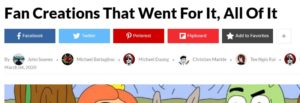
But in an appalling act of ‘popping in just to talk about myself’, I just wanted to mention that I’m one of the co-authors of an article which was published this week on the popular US comedy website Cracked.com.
It’s about extraordinarily dedicated fan projects, and you probably won’t be surprised to hear that my contribution is the section about an unjustly overlooked UK comedy show. If you get a chance to look at it, I’d be interested to hear what you think.
I’m inclined to sign off with a promise to be back again soon with some moe content, but I’m rather reluctant to do so in case I end up making myself into a fibber… so I’ll simply say that I will return: the timeframe for that… gawd only knows.
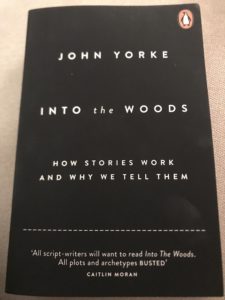 I’m currently reading Into The Woods by John Yorke, which (as you may know) is about stories and storytelling. Unsurprisingly, it features quite a bit of discussion of structure, which is a subject I’ve been thinking about quite a lot recently, and in the spirit of self-indulgent sharing, it’s the springboard for this blogpost.
I’m currently reading Into The Woods by John Yorke, which (as you may know) is about stories and storytelling. Unsurprisingly, it features quite a bit of discussion of structure, which is a subject I’ve been thinking about quite a lot recently, and in the spirit of self-indulgent sharing, it’s the springboard for this blogpost.
Cards on the (perfectly square and clean-baized) table: I like structure. And I like it both as a reader and as a writer. As I’ve written before, my tiny mind was happily bent out of shape many years ago when I started reading and watching things that played with form and chronology and the like, and I still delight to this day in works which don’t draw a straight line from “Once upon a time…” to “… happily ever after” (provided it’s in service of the story; if it’s just done for its own sake, I may wonder if there’s some shortcoming in the story which is being disguised by shuffling the chronology or whatever – and I’d go so far as to suggest that might well be the case with my own first published work. But I digress, and this parenthesis is getting unworkably long, so I’ll close it and then put a full stop and we can move onto a new paragraph).
 Maybe I’m being optimistic, but I think there’s been a bit of a rise of narratives with unusual structure over the past few years – to give a couple of examples,the success of Gone Girl in both written and filmed form was testimony to audiences’ willingness to watch events play out of sequence, and complex structure was a key aspect of Steven Moffatt’s work on Doctor Who (though he doesn’t need time travel as a plot device to enable this kind of thing, as fans of his earlier work Coupling [and I am one of those fans] will be aware). There are often suggestions that audiences are becoming increasingly sophisticated and aware of how narrative works, and I guess that willingness to accept breaking and bending of the A to B shape of a tale may well be a part of that.
Maybe I’m being optimistic, but I think there’s been a bit of a rise of narratives with unusual structure over the past few years – to give a couple of examples,the success of Gone Girl in both written and filmed form was testimony to audiences’ willingness to watch events play out of sequence, and complex structure was a key aspect of Steven Moffatt’s work on Doctor Who (though he doesn’t need time travel as a plot device to enable this kind of thing, as fans of his earlier work Coupling [and I am one of those fans] will be aware). There are often suggestions that audiences are becoming increasingly sophisticated and aware of how narrative works, and I guess that willingness to accept breaking and bending of the A to B shape of a tale may well be a part of that.
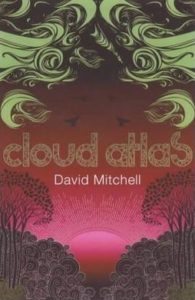 But whether it’s part of a wider phenomenon or not, I’ve long been a fan of structure; as a reader, once I recognise it, I find it reassuring (and in the case of Cloud Atlas, it took me until the midpoint of the book to realise what the author was doing, but when the penny dropped, it did so in a very satisfying way), and as a writer – you knew I’d get to this eventually – I find it very useful.
But whether it’s part of a wider phenomenon or not, I’ve long been a fan of structure; as a reader, once I recognise it, I find it reassuring (and in the case of Cloud Atlas, it took me until the midpoint of the book to realise what the author was doing, but when the penny dropped, it did so in a very satisfying way), and as a writer – you knew I’d get to this eventually – I find it very useful.
I’m a plotter, through and through, and like to have a pretty firm grasp on where the story’s going before I set down even the first line; I’m not one of those people who conjure up characters and then set them off into the environment of the story and see what happens – as novelist Sarah Perry says at about 2m38s in this podcast…
… the characters are plot devices; they’re adrift in the sea of the story, and they can no more shape the tides than you or I can.
 And from a writing standpoint – and especially working, as I do, in the crime/thriller genre where plot is key – there’s something very useful about having a structure to work to; that might be a simple three or even five act structure, it might simply mean having the story starting and ending at the same place or in a similar way to hint at some idea of symmetry, or whatever, but if you have a structure sorted out ahead of time that lets you know what you should be writing about next, then that’s very useful indeed.
And from a writing standpoint – and especially working, as I do, in the crime/thriller genre where plot is key – there’s something very useful about having a structure to work to; that might be a simple three or even five act structure, it might simply mean having the story starting and ending at the same place or in a similar way to hint at some idea of symmetry, or whatever, but if you have a structure sorted out ahead of time that lets you know what you should be writing about next, then that’s very useful indeed.
My most recent completed novel, Captives, was very deliberately structured from the outset of the writing process, because I knew that I wanted to have an investigation taking place in the present day, but I also wanted to detail the events which led up to the start of the story, to give a sense of what the stakes were and of the players involved. Rather than do this through infodumps disguised as dialogue or anything like that, I opted to alternate sequences set in the present with flashback chapters which grew progressively closer to the inciting incident which happens a couple of hours before the start of the first chapter; once I’d cracked that approach, it made things a lot easier – though I still regret the fact that as I counted down from ‘Twelve years before’ to ‘one day before’, I couldn’t make the time-jumps involved align with a reversed version of the Fibonacci Sequence… though given how pretentious that sentence looks when typed out, maybe that’s for the best.
So, as you can imagine, I was keen to see if I could take the same approach with the next novel (working title: Refuge). Once I’d had the characters sketched out, and the sequence of events worked out, I wondered if it would be possible to create a structure which would serve the story – as the book’s about a kidnapping, I wondered if I might be able to rotate the narrative point of view so that we’d hear from The Detective, then The Kidnappers, and then The Kidnappee, before rotating back to the Detective again. I’m particularly keen to make sure we spend as much time as possible with the Kidnappee, as it often feels that people in such stories run the risk of being little more than a MacGuffin, or ‘item’ to be retrieved, and I wanted to avoid that.
However – and you’ve probably already spotted this – the problem with this idea is that (non-spoiler alert) the kidnappers and the kidnappee unsurprisingly spend a lot of time in the same locale, so whilst I could convey a fair amount of detail on events by jumping from our detective to the villains, there’s little additional material (save for internal monologue and the like) that would be conveyed by the jumping to the kidnap victim. I’d effectively end up spending 2/3 of the narrative time on the baddies and their environment, which would make it hard to describe what was going on outside of that without the book becoming excessively long.
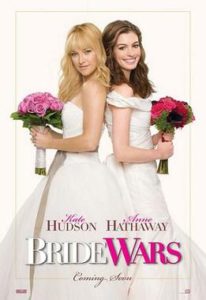 However, given that the story is in itself a ‘ticking clock’ tale with a set ending looming on the horizon and moving closer in stages (akin to most films featuring weddings, for example: the wedding is a fixed point in time and everything we see is drawing us closer to that), it did occur to me that having a race against time which is also viewed through the fragmented narrative of rotating POVs would perhaps be too much to put on top – and given that (again, non-spoiler, given the genre expectations) the paths of the Detective and the Kidnappers will inevitably cross, whose narrative section should I include that in? The Detective closing in, or the Villains realising that things aren’t panning out as planned? I wasn’t sure.
However, given that the story is in itself a ‘ticking clock’ tale with a set ending looming on the horizon and moving closer in stages (akin to most films featuring weddings, for example: the wedding is a fixed point in time and everything we see is drawing us closer to that), it did occur to me that having a race against time which is also viewed through the fragmented narrative of rotating POVs would perhaps be too much to put on top – and given that (again, non-spoiler, given the genre expectations) the paths of the Detective and the Kidnappers will inevitably cross, whose narrative section should I include that in? The Detective closing in, or the Villains realising that things aren’t panning out as planned? I wasn’t sure.
Ultimately, I’ve decided to keep it straightforward, shifting scene as required whilst trying to maintain the sense of a countdown, and to find other ways of including the relevant background information and internal monologue of the Kidnappee. We’ll see how it goes – and given how cathartic and therapeutic it’s been (for me, I mean – I’m sure this has been less so for you) to discuss it here, I’ll see about reporting back on how well (or otherwise) it works out.
Given how writing’s an essentially solitary process, and how every 100,000 words is probably more like 300,000 or so re-written and edited and generally switched around in the writing process, talking about it in this way is very probably just an attempt to provide an almost contemporaneous ‘director’s commentary’ during the process of writing it. Which in itself could be distracting – and is often the reason I cite (with varying degrees of truth) for my infrequent blogging.
Thanks for reading this long sprawling post, and if you have any thoughts, insights or tips on structure, or examples of great structures which amplify or serve the story, please do leave a comment below, I’d like to hear other viewpoints on this.
But enough musing and prevarication: back to the actual writing…
Well, the book is finished and the submission process underway, so I have time to blog – so thought instead of making apologetic noises without posts actual substance, I’d share a pseudo-review (with photos). Is that okay? Yes? I’ll take your silence as the sound of nodding.
As I may have mentioned, I live in London, and I read comics regularly, so I was intrigued when I saw this poster on the tube recently:

A bit of internet searching dug up that it’s an exhibition which has previously been shown in France (where comics are treated like any other medium), and stated that as well as original art pages from lots of comics, they’d be exhibiting costumes from most of the DC Comics-based films and TV shows, so yep, I was into that.
(Sudden realisation: ‘DC Comics’ is one of those redundant phrases like ‘PIN Number’ or ‘TSB Bank’, but I don’t see myself changing the way I say it in any kind of hurry. Anyway…)
So I booked and went along the other day, and (TL;DR summary) I thoroughly enjoyed it. Good array of items from DC’s history on page and screen, and as they don’t mind you taking photos (in fact, staff seemed keen to let me know about it), here are some pictures – not necessarily in order – and my sillysod comments…
Unsurprisingly, it starts with Superman (who’s 80 this year, though with all the reboots and reimagining, he looks pretty good on it, I think we can agree). Quite a few original art pages from Action Comics both old and recent, but then I spotted this:

Yep, that’s Christopher Reeve’s costume from the first Superman film. And yes, it’s tall, but he was tall, and he also gave one of the most enduring performances of the character (I mean, look at the videos of his transformations on this page – that’s acting). Terrific actor, and great to see his costume up close.
Speaking of up close, I certainly leaned in to look at these original art pages from Superman Annual 11:
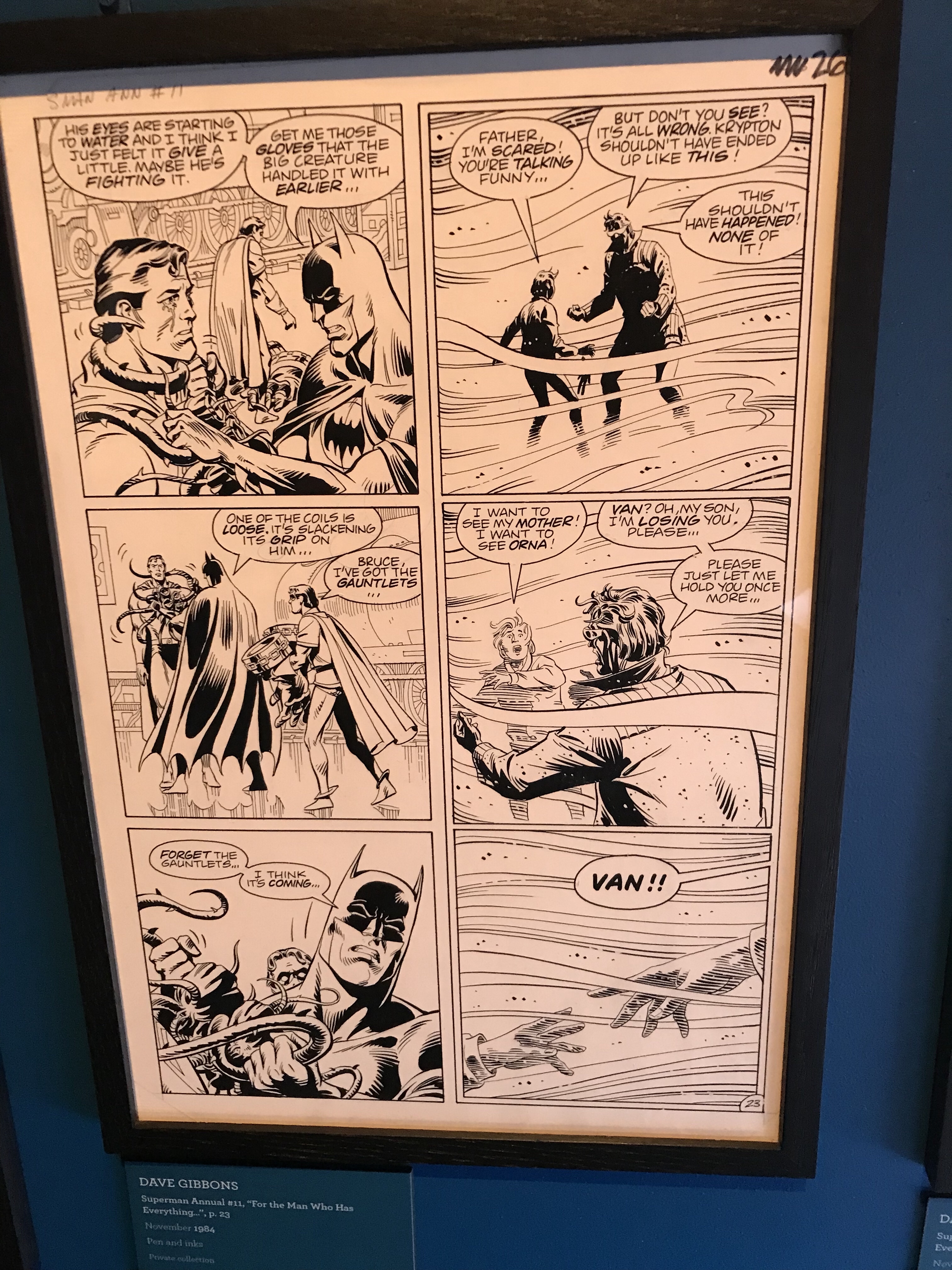
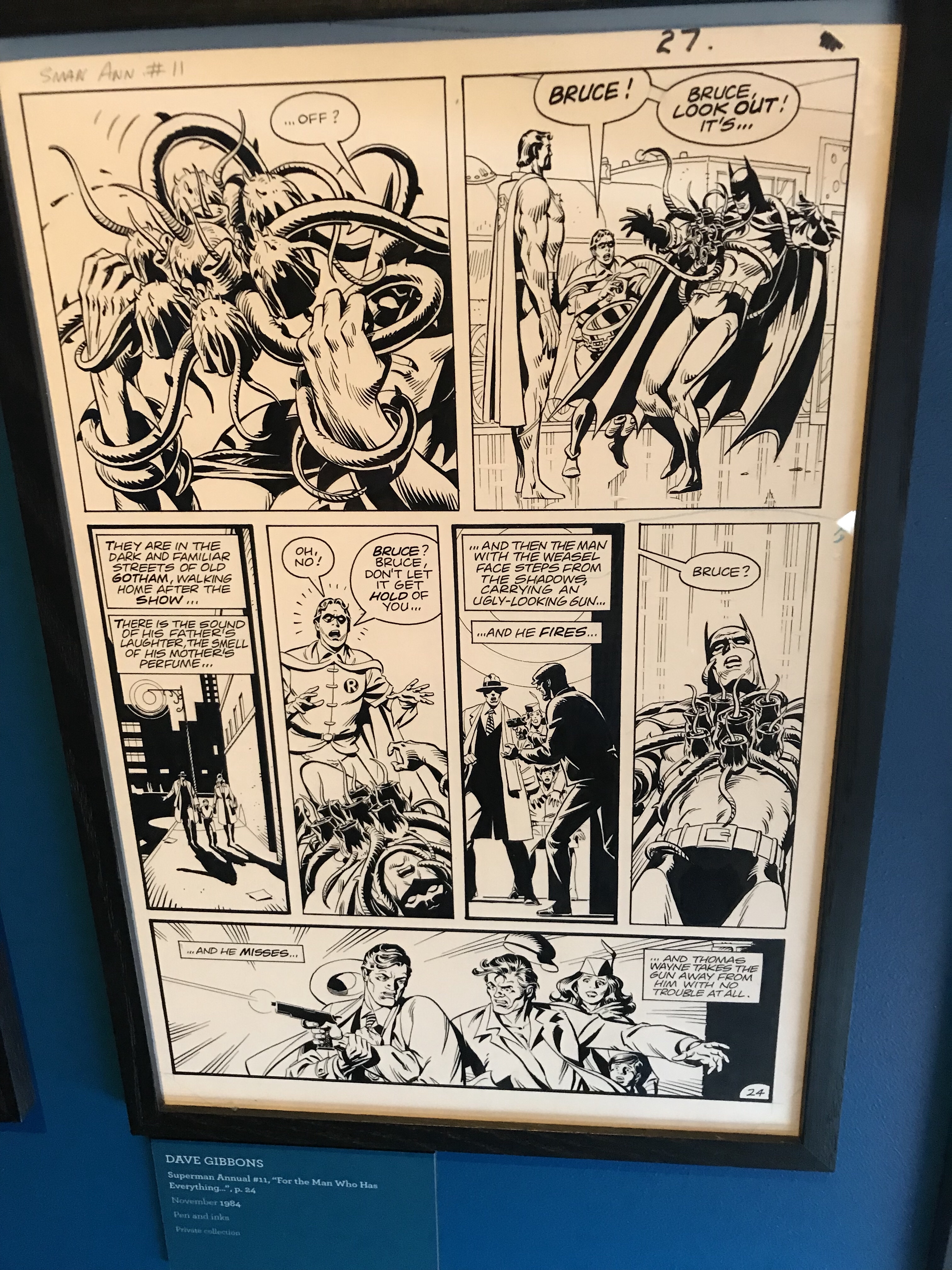
The art’s by Dave Gibbons, from a script by Alan Moore, and … well, they’re two creators who have had an immense impact on the comics field (and beyond) – probably because they’re both immensely talented.
The middle of the exhibition is about Batman, one of my favourite comic characters, and spans pretty much all the filmed appearances – here’s one of Frank Gorshin’s Riddler outfits from the 1960s Batman TV show:
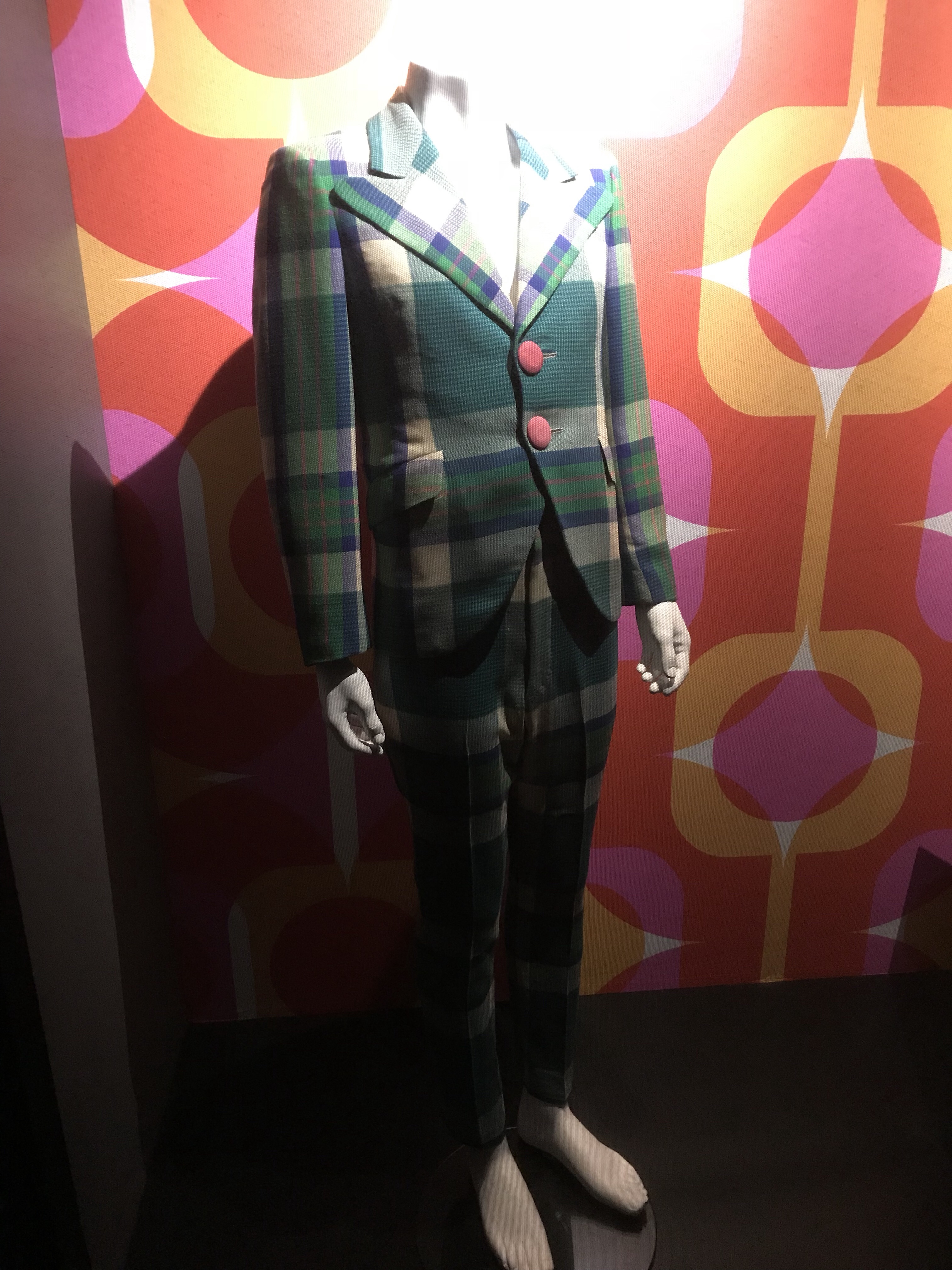
A selection of costumes from the Keaton/Burton films:
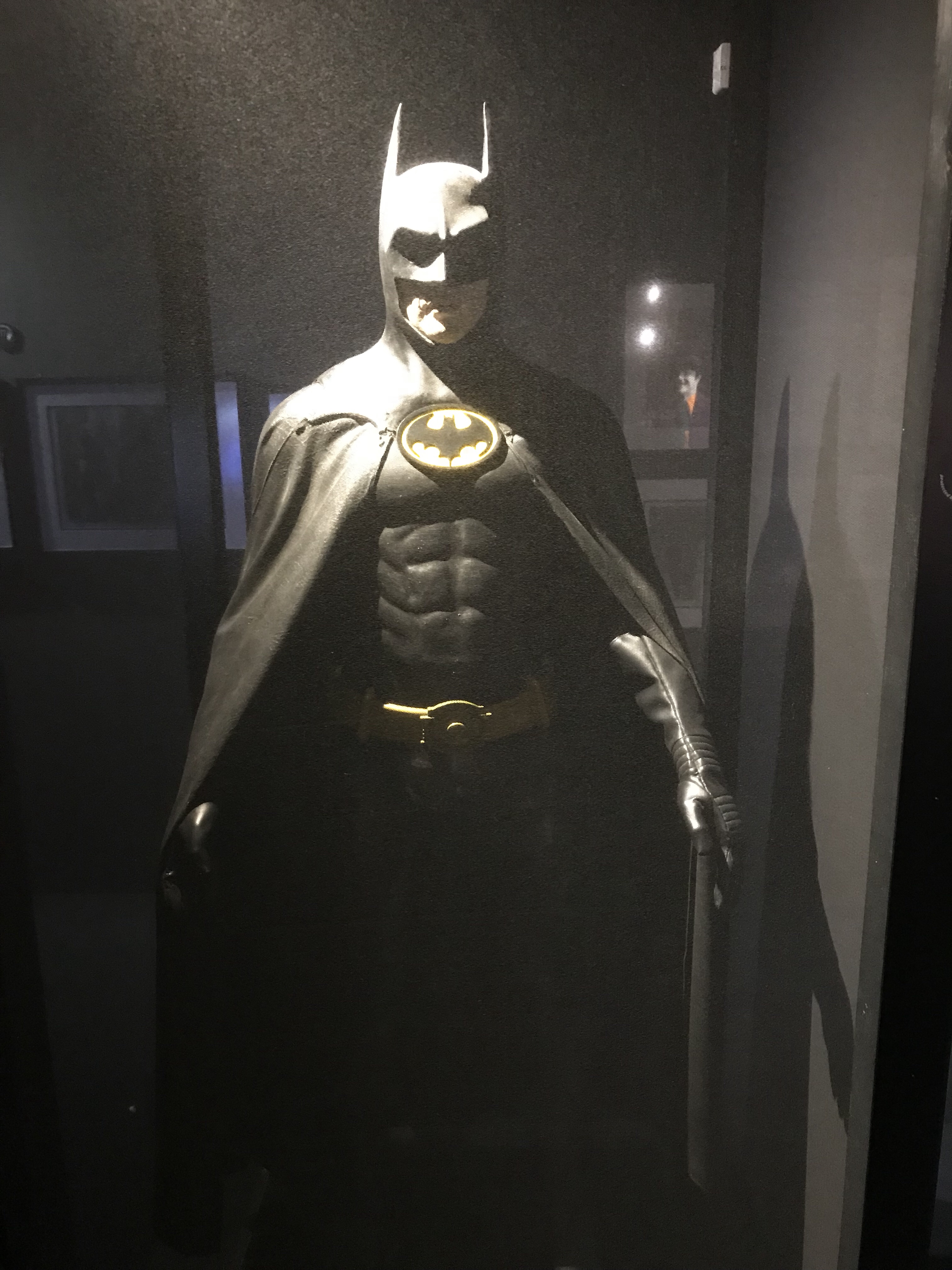


And then from the Kilmer/Clooney/Schumacher films:
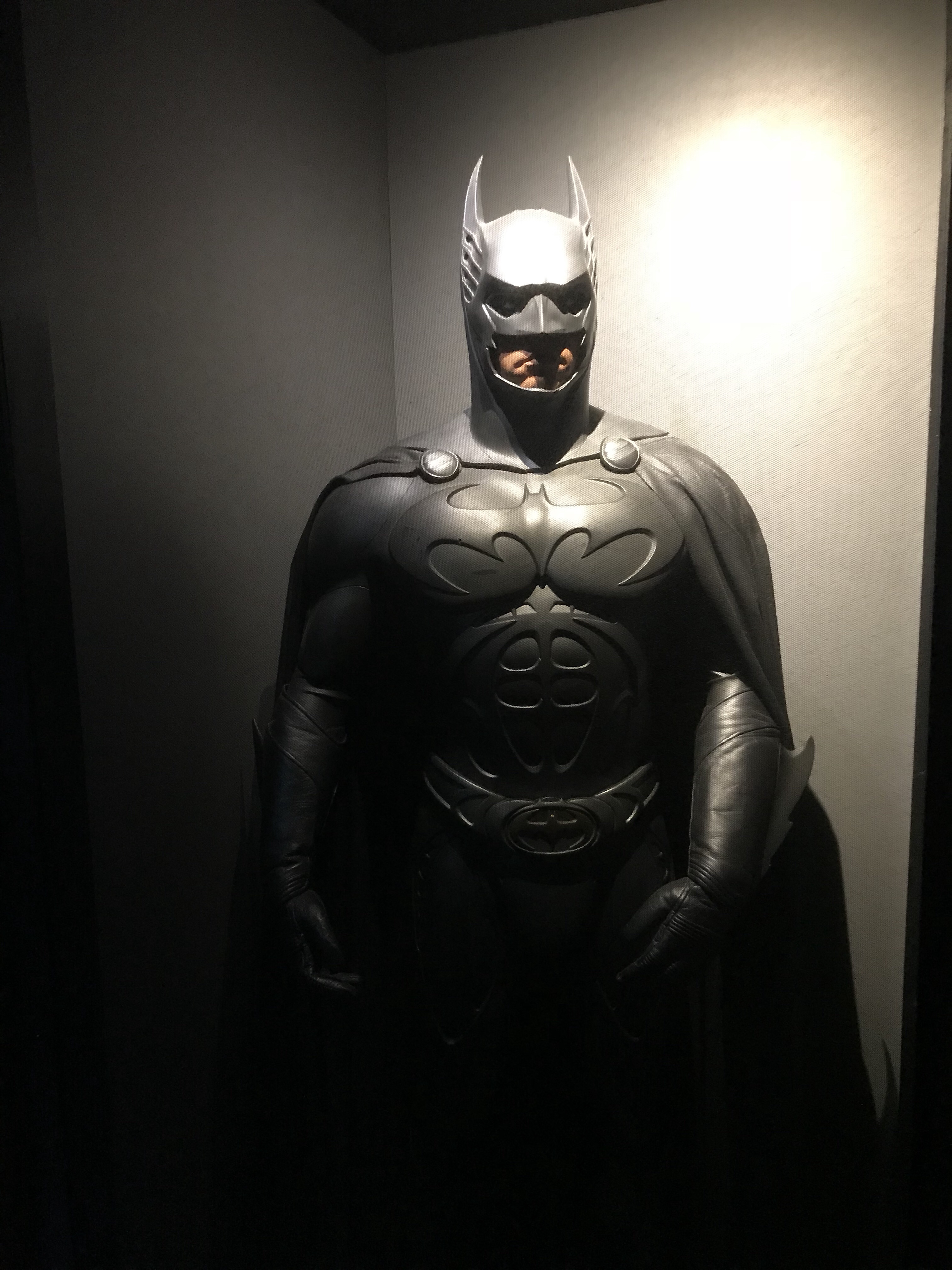
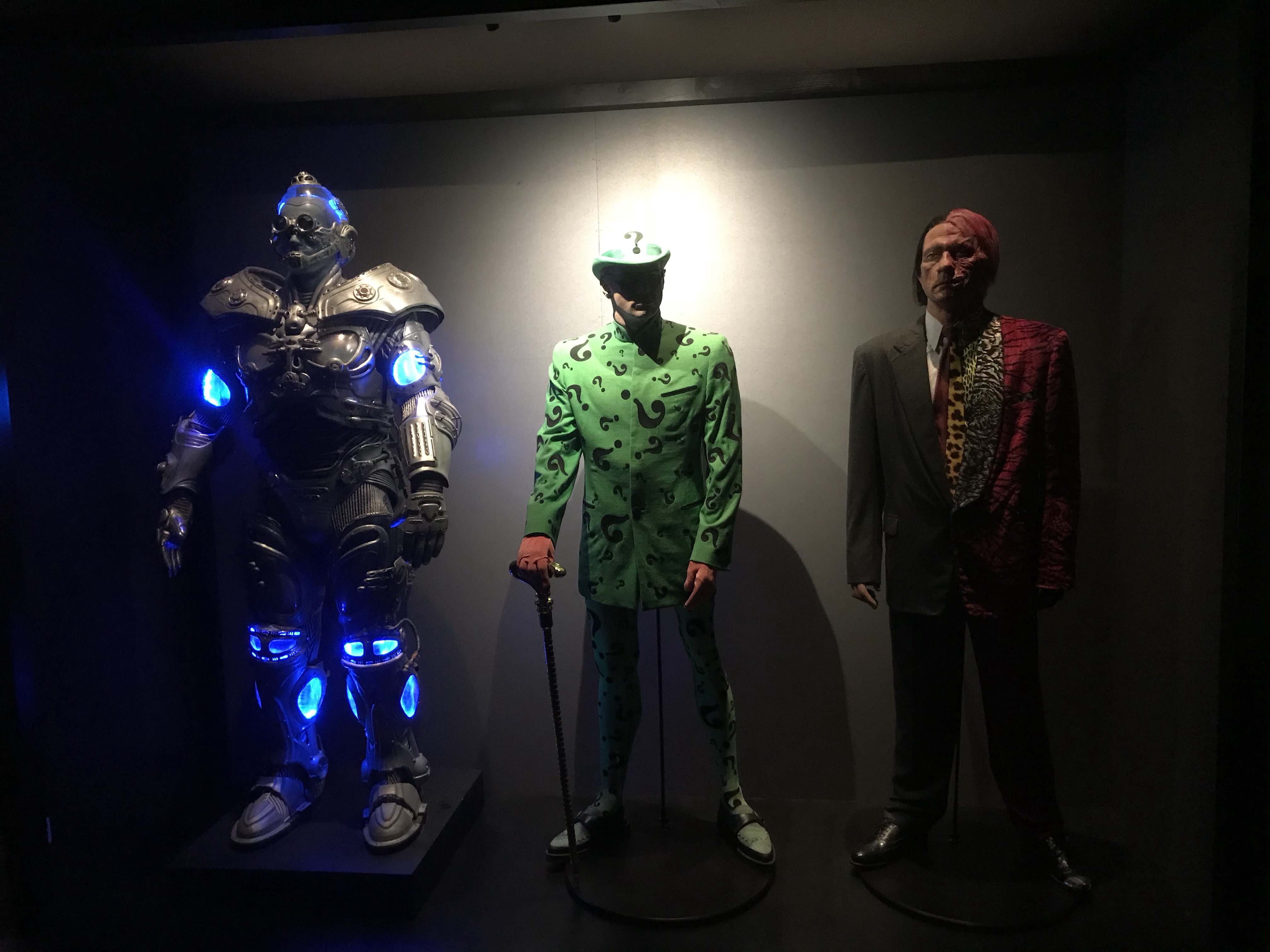
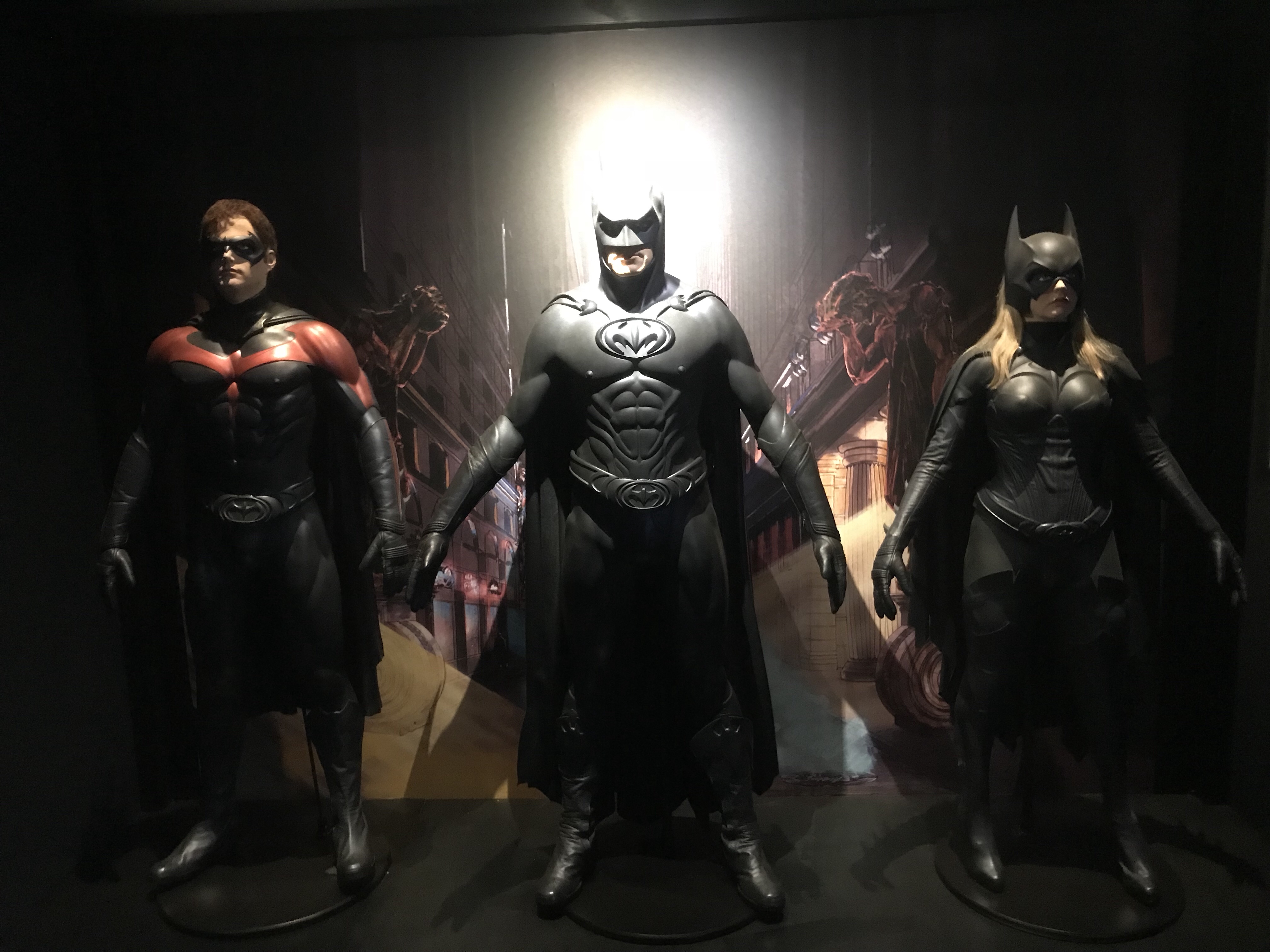
And on to the Bale/Nolan films – both costumes…

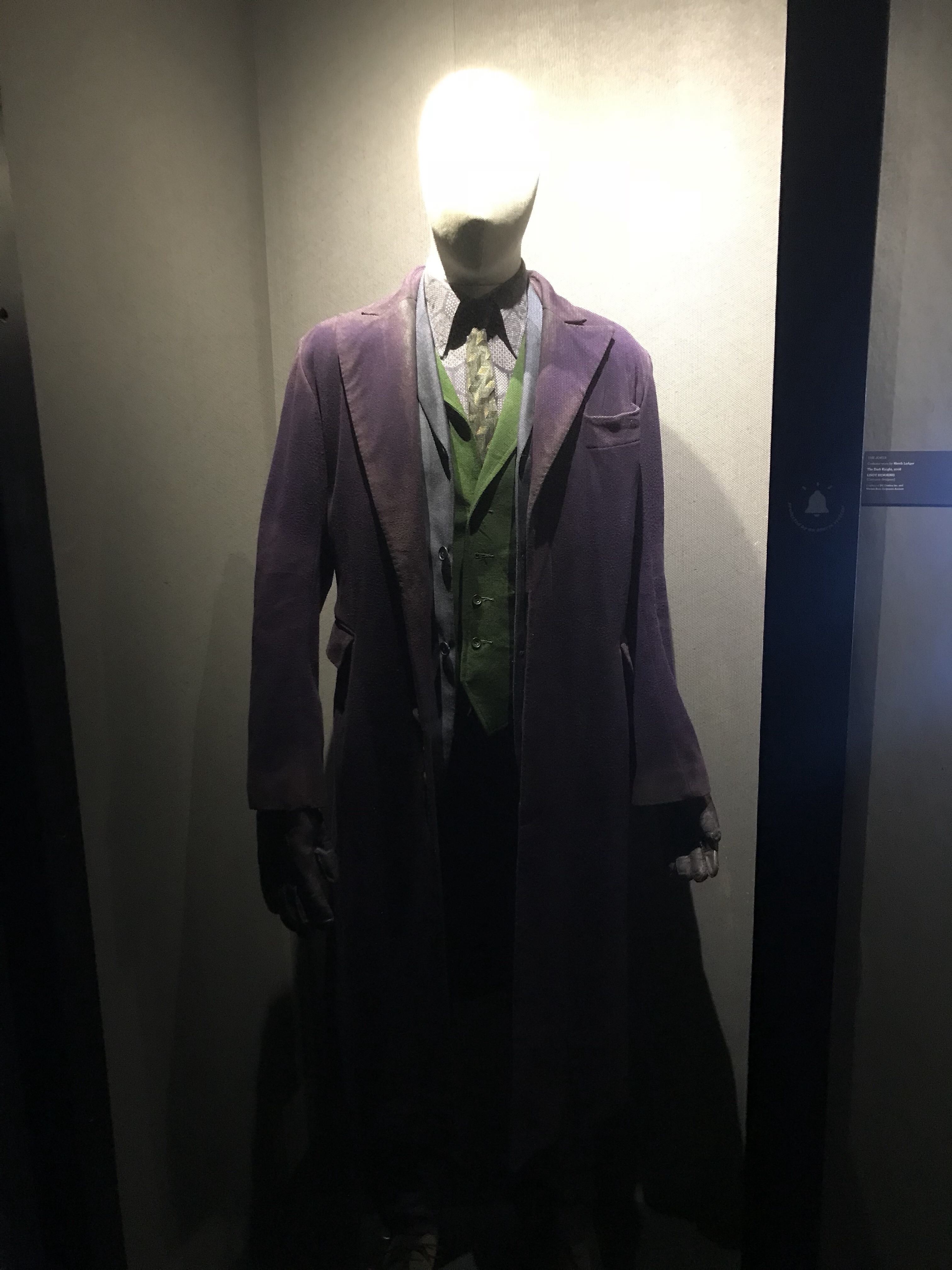

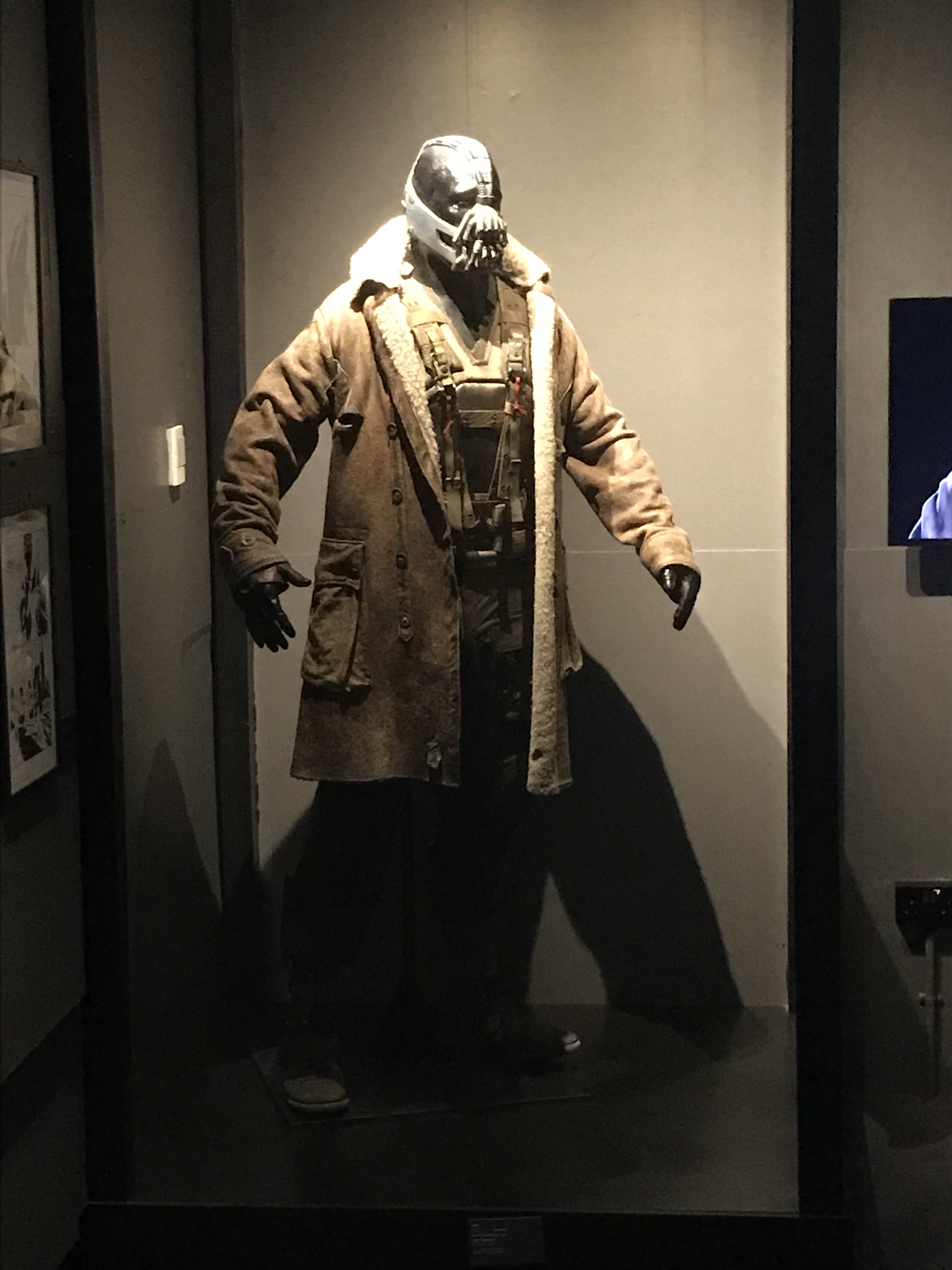
…and prop vehicles:


There’s more comic art, including painted pages from Grant Morrison and Dave McKean’s brilliantly brain-bending Arkham Asylum:
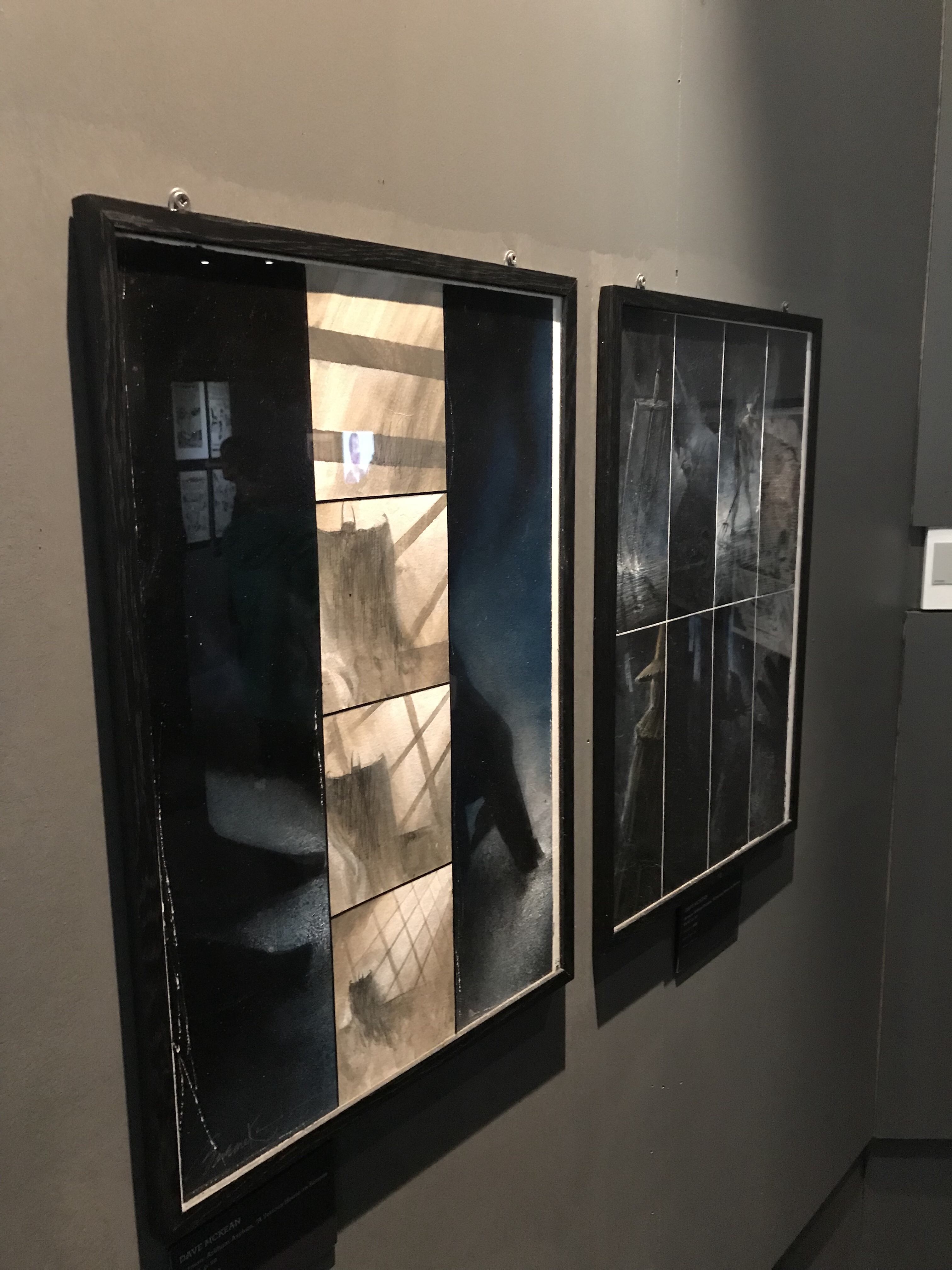
And pages from Frank Miller, Klaus Janson and Lynn Varley’s Batman: The Dark Knight Returns (a series which certainly helped make the Batman films from the 1980s onwards possible).
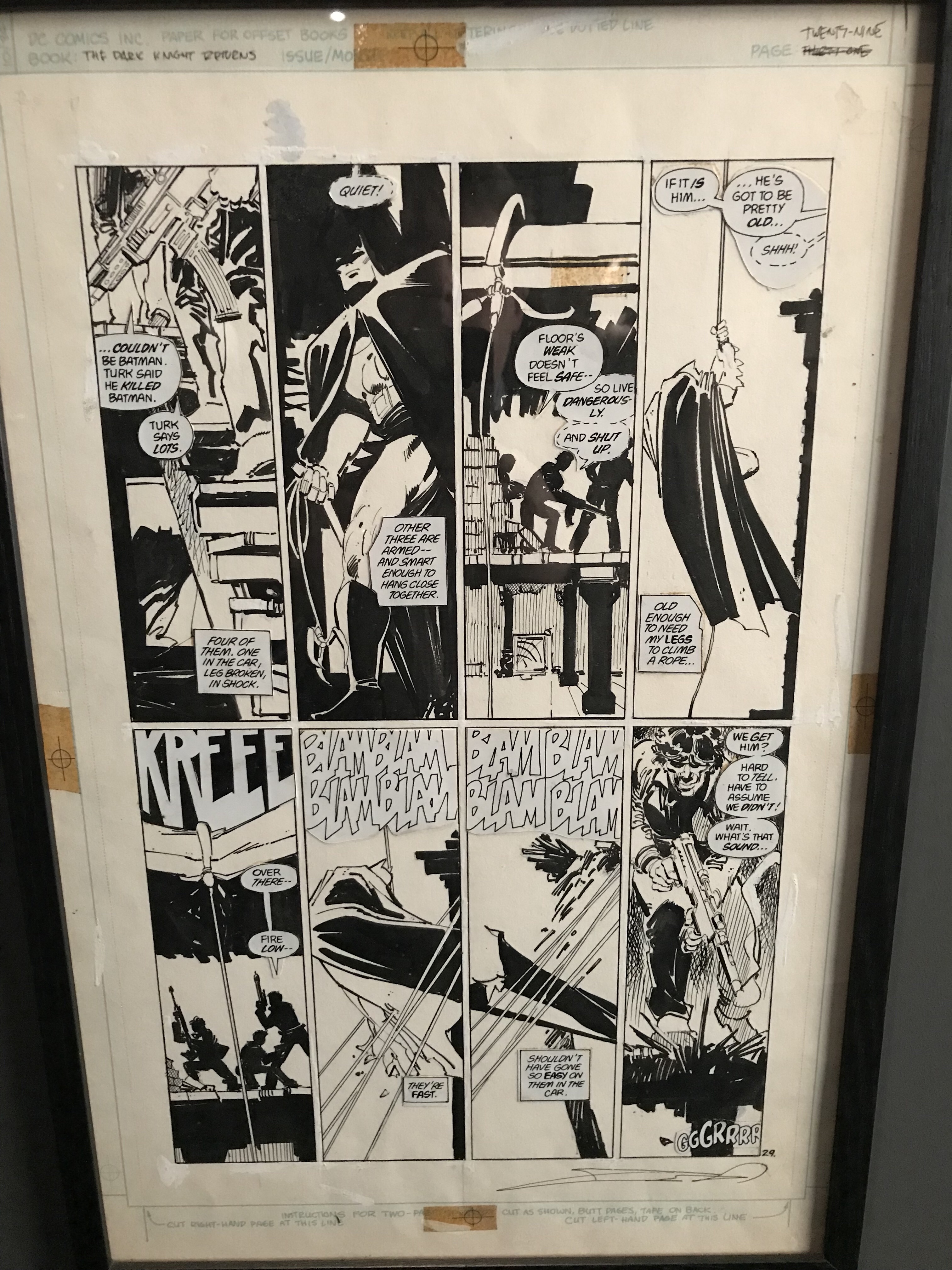
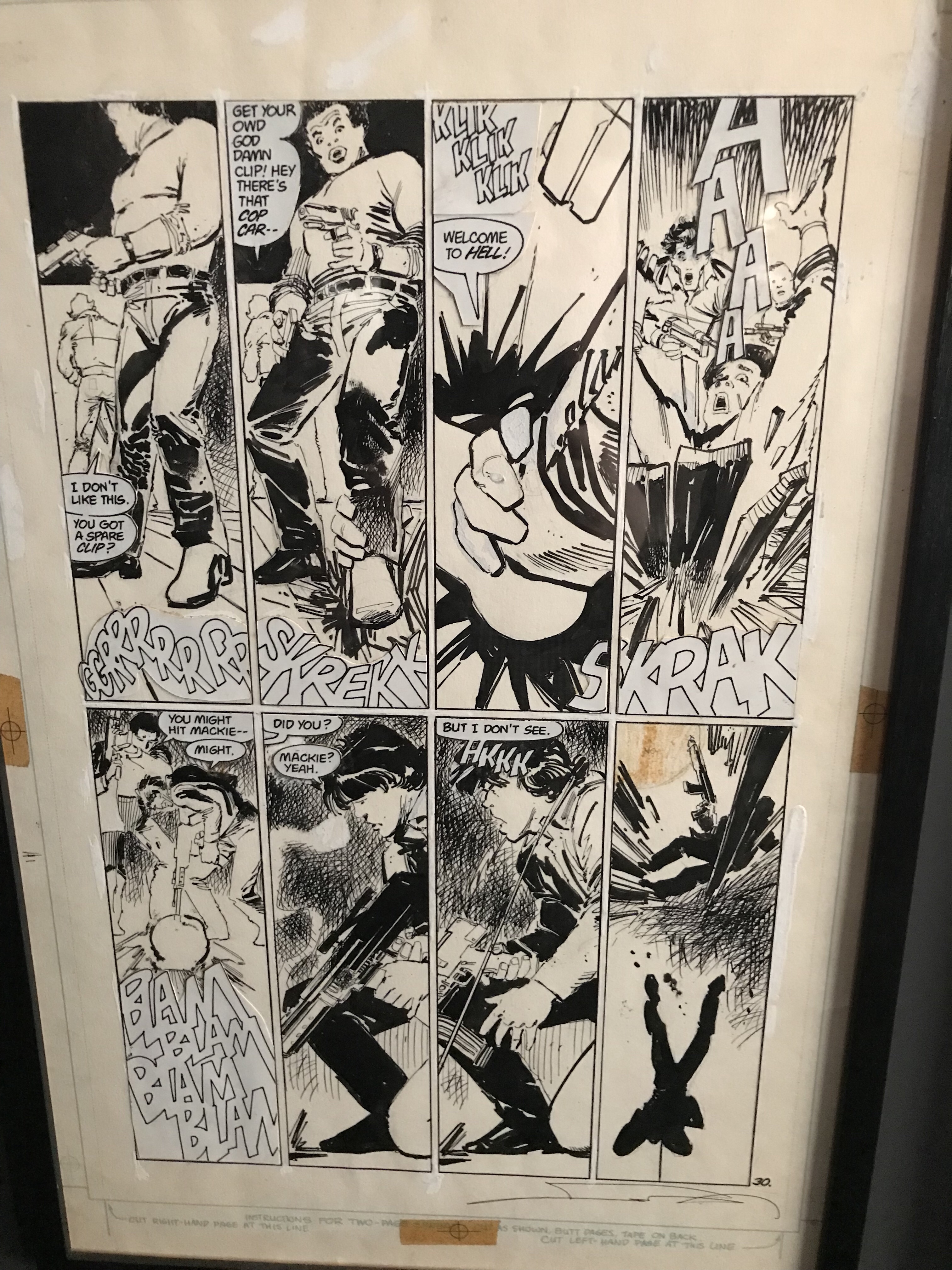
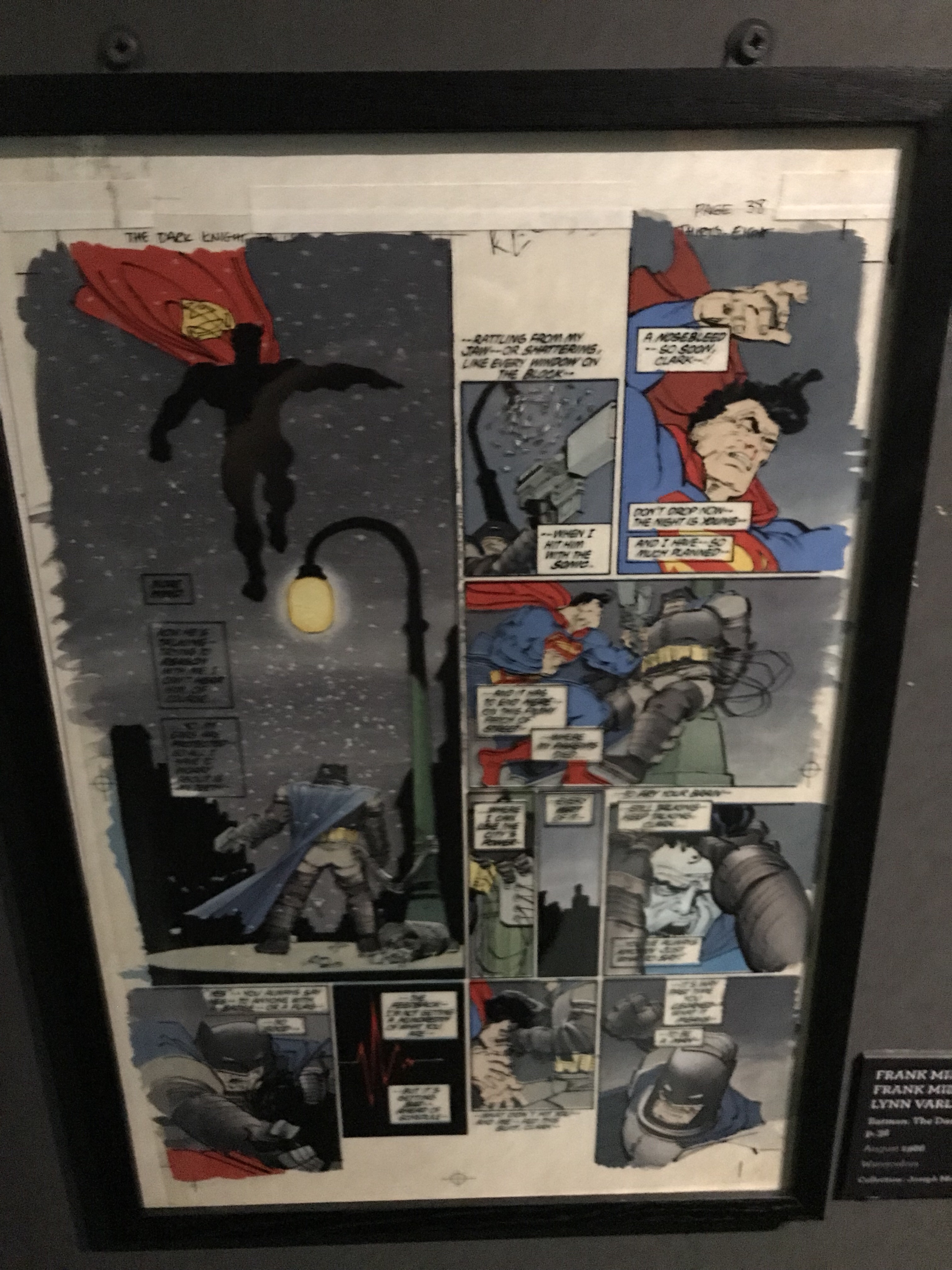
There are also props and costumes from a lot of the more recent films – the Snyder-era films, Suicide Squad, and Wonder Woman.
Have to admit that I haven’t seen the Jenkins/Godot WW film yet, but I hear good things about it, and I’m favourably inclined towards it (just haven’t got round to it yet, it’s as simple as that), and it’s interesting to see the differences between the costume from the fondly-remembered Lynda Carter TV show –
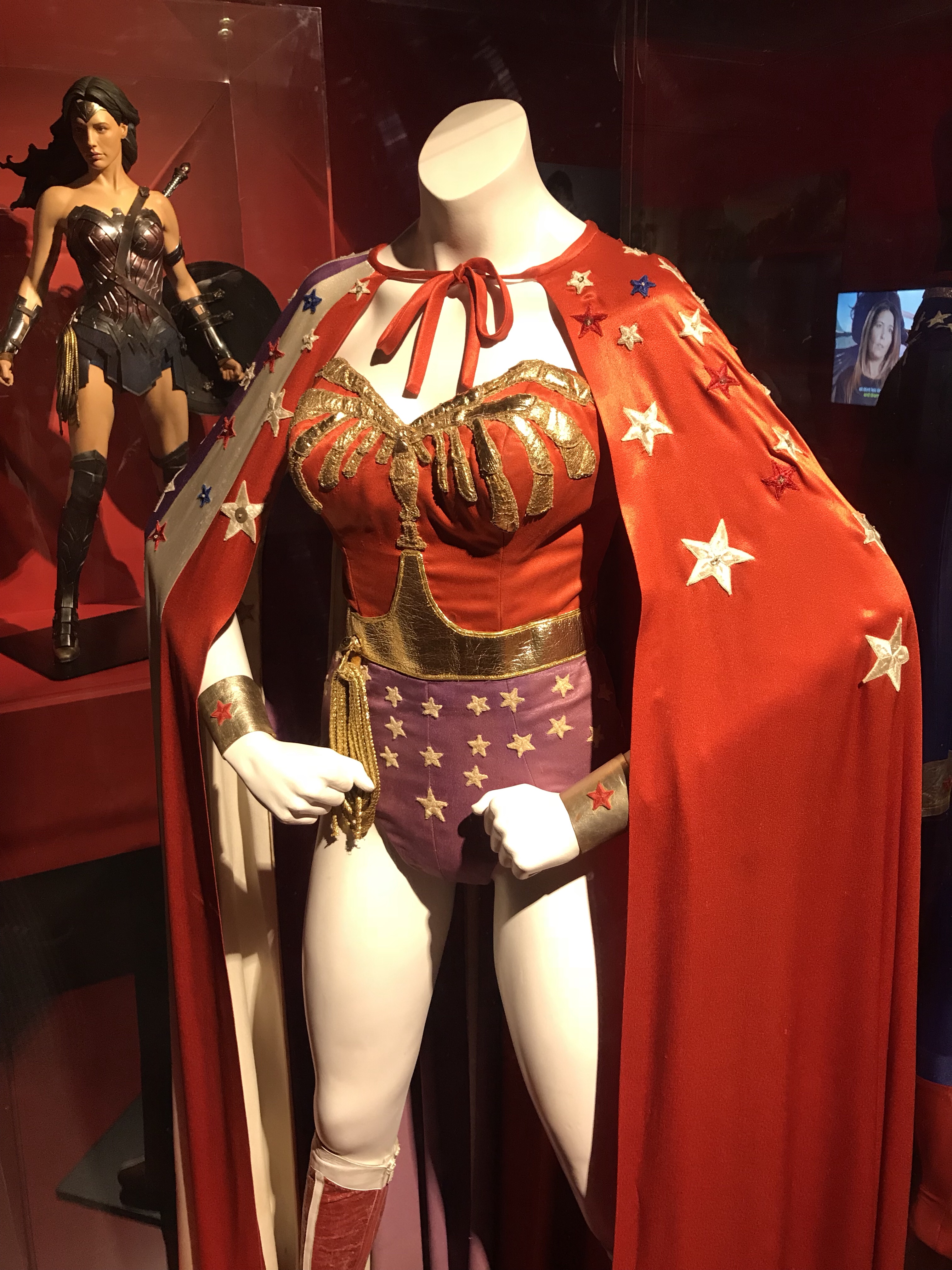
and the more battle-oriented costume as worn by Gal Godot:

Granted, there are differences in the materials etc available, but even back in the 70s they were able to make chain mail and other armour stuff for films, so I tend to imagine it reflected 1970s thinking that the emphasis was on a ‘softer’ ambassador role for Diana, rather than the more warrior-based version I gather we see in the recent film. Both are equally valid readings of aspects of the character, to my mind, and show how (as with any long-running character, really) successive generations take what most resonates to the perceived audience at any given time, and focus on that.
But I digress (as my long-time readers will recognise as a statement of policy more than an occasional observation); there’s a lot of interesting and nostalgia-provoking stuff to be seen at the exhibition, as well as a pretty good gift shop, so if you’re interested in DC superheroes on the page and/or screen, I heartily recommend a visit – this link gives more info. It runs until September, I believe.
If you do go along, why not leave a comment about what you thought of the exhibition (or just remind me of key elements I forgot to mention – I’m sure there are some)? Keen to hear other people’s opinions on it!
Anyway, this blog is not dying, it’s moving – or, to be more accurate, I’ll be moving my attentions to my ‘new blog’ and so I doubt I’ll be posting here again (techical issues permitting) for the foreseeable future.
The reason for the move is pretty simple, really – for some time, I’ve been looking into trying to ‘streamline’ the number of places and locations I occupy online, and so I’ve revamped and reshaped my website so that it now includes automatic updates on my Twitter messages, and so it only seems logical that I shift the blog updates over there too.
I speak with utter confidence about this move, but of course if the server crashes or my technical ability reaches its limits, I may well be here again, so I won’t be deleting this blog. Many of the links which you can see in the right-hand column are on the new site, so you don’t have to feel lost and disoriented if you just use his blog as a stepping-stone to other people’s pages. I don’t mind being the guardian of the crossroads, even if Robert Johnson had his misgivings…
Anyway, I hope you’ll come and visit the new blog, and maybe you’ll even be so kind as to add John Soanes to your list of bookmarks? Thanks in advance.
Finally, if this is your last time of visiting, many thanks for your time and eyeballs over the last few years. It’s much appreciated, and as intermittent as my updates may have been in the last year or so, it’s always been reassuring to know that you fine folks were out there reading my nonsense. Seriously, you’ve been fantastic.
And you know what? So was I.
I think it was the late (and in my estimation rather great) Blake Snyder, author of the screenwriting book Save The Cat who came up with the concept of ‘Double Mumbo Jumbo’, and it’s something I’ve been thinking about a bit recently.
Double Mumbo Jumbo, put simply, is the idea that “as an audience we can only buy one piece of magic per movie” (or, I’d say, book or play or other medium). Where Blake says ‘magic’, I like to think this equally means coincidence – for my money, Spider-Man 3 suffers from Double Mumbo Jumbo in the plotlines relating to the Venom symbiote (to non-comic geeks, that’s the black costume-thing which bonds first with Peter Parker and then with his rival) when it happens to land first near Peter Parker’s moped (if memory serves; I’ve only seen the film once, and don’t plan to watch it again, even if it means verifying details for a blog post) and then it’s roaming ownerless again when Peter Parker’s workplace rival is out and about in the area.
I think the second story in Pulp Fiction suffers from this sort of coincidence problem as well, though I know a lot of people hold that film in much higher regard than I do.
It’s not just a problem which you see in films, either (though the example I’m about to give was, I think, adapted to film): the novel Perfume by Patrick Suskind is very well-respected and was given to me with strong recommendations by a friend, but when I read it I couldn’t get past the fact that the main character had no personal scent (which struck me as being biologically unlikely) and also had an extrememly sensitive ability to detect odours.
This felt like a cheat to me, as if the author realised that someone with a truly super-powered nose would be unable to smell anything beyond the scent of their own sweat and clothing. I didn’t buy it, and as a result the rest of the book felt hard to swallow, built as it was on a foundation that I didn’t find particularly sturdy.
This has been on my mind a bit recently, because in the novel I’m currently writing (due for completion about half an hour before the heat-death of the universe, longtime readers might suspect) I have various ‘secret’ government agencies and bodies, and I don’t want to have too much stuff that looks like a fudge – whilst I’m confident that most readers will accept that there are bodies within government and the military which don’t appear in annual reports and budget publications, I don’t want to make it look as if I’ve made them ‘secret’ just so I haven’t got to do the research on Home Office heirarchies and departmental responsibilities and the like.
In a strange – though hopefully understandable – tangent, thinking about the concept of Double Mumbo Jumbo has partly explained to me why I find the following advert irks me more than it probably should:
The advert doesn’t really make sense to me on any level – and yes, I know it’s meant to be a bit out there and surreal, but consider the things that we’re supposed to accept:
- He’s so fond of sausage rolls he’s cloned a miniature dog to say what he can’t
- He carries the miniature dog in a jewellery box in his pocket
- He had it in his pocket, but initially wasn’t intending to hand it to her (note how he turns away at first)
- The ‘garage lady’ accepts what appears to be a gift of jewellery from a customer
- The miniature dog speaks english (with, I think, the voice of Mathew Horne)
- The dog knows which button to press on its (also miniaturised) keyboard to start the music (which is either drum and bass or garage, I think – I’m not bothered about either of those choices really, though I hope it’s the latter as it would be appropriate given the setting of the advert)
It just feels like the advert-makers have hit the ‘random’ button in an almost cynical way, as if throwing diverse stuff together like that immediately equates to something surreal and/or clever. The main problem I think I have with it is that for someone who’s “just a bloke”, and apparently incapable of expressing himself, he’s gone to a lot of trouble (and a weird kind of trouble) to express his gratitude.
In fact, within this universe where we can create speaking miniature animals to perform tasks we humans can’t, I’m surprised that there are petrol stations at all, as the normal rules don’t seem to apply; surely the pumps dispense some kind of liquid boulders, and the ‘garage lady’ is in fact the reincarnation of Alexander the Great, wearing a human outfit to disguise the fact that he’s come back as an oversized moth (I’m aware that many insects’ tracheas don’t function once they get above a certain size, so this is an inherently unrealistic proposition, but given that the shruken dog apparently suffers no difficulty breathing despite his size and being enclosed in a small box, it seems all bets are off). Actually, it’s strange that this bizarre world they inhabit has sausage rolls and money in it at all really. What are the odds of that?
I can live with the odd quirk or wrinkle to things – and as I understand it, much of the ‘magic realism’ school of writing is based on the world as we know it reacting to strange and unusual things happening – but it needs to be balanced, I think. The Queen in Alice in Wonderland boasts “sometimes I’ve believed as many as six impossible things before breakfast”, but that advert seems, to me, to be a case of Multiple Mumbo Jumbo, and so I can’t swallow it (then again, as a vegetarian, I was probably unlikely to swallow anything related to sausage rolls).
Come to think of it, no wonder the chap in the advert accepts the strange world he lives in: it’s clearly the early hours, and maybe he needs to believe the six impossible things I list above before he can have the sausage roll – that is, his breakfast.

